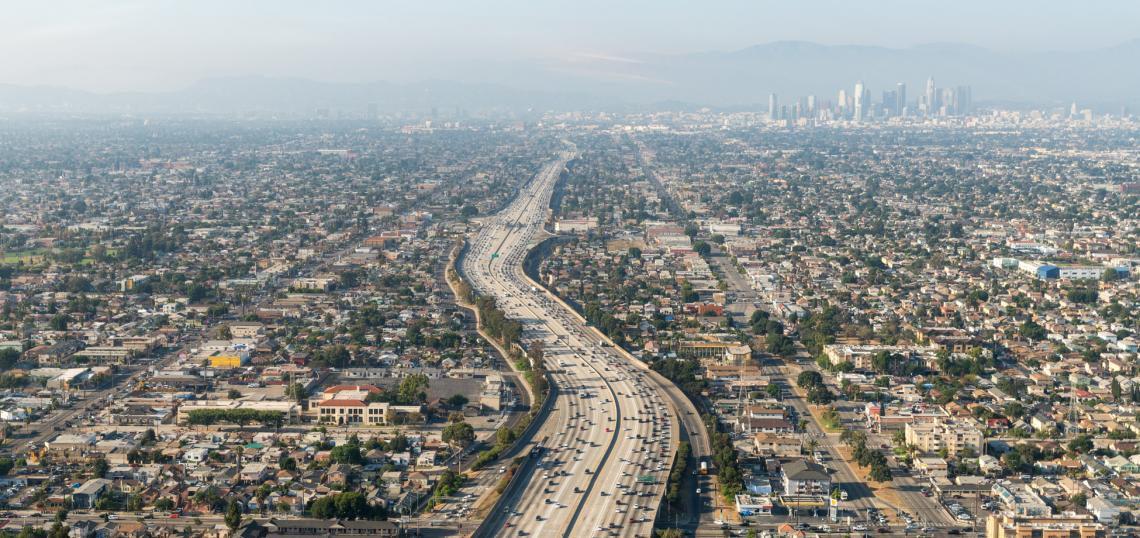California in 1960 was a place on the move. Edmund G. “Pat” Brown Sr. - who served the as the state’s governor from 1959-1966 - spearheaded three major initiatives aimed at providing a piece of the California dream for all residents of the state. In doing so, Governor Brown became the architect of modern California.
First, the California State Water Project - created to make sure the entire state was “water secure” - has been called by historians the "most significant public water project in world history."
Second, the governor pushed numerous transportation projects that linked residents up and down the state.
Third, the California Master Plan for Higher Education expanded our state’s universities to become the world-class public institutions they are today - initially free of charge. Pat Brown realized the dream of free university education fifty years before Bernie Sanders ran for President on the idea. Later governors insisted on charging tuition.
Finally, at great political expense, the governor stuck his neck out to pass the Rumford Fair Housing Act. One of the first bills in the nation to address discrimination in housing, the Rumford Act set a national precedent that eventually resulted in passage of the Fair Housing Act in 1968, which outlawed discriminatory real estate practices nationwide.
These public investments paid off. In 1960, California had fifteen million people. Today we have forty million people and are the world’s fifth largest economy.
Under Governor Brown we had an agreement: Come to California and work. You didn’t need to create a successful tech company, become a movie star, or start a hedge fund. You just needed to come and work. We will educate your children and provide the infrastructure to accommodate the housing needed to experience the California dream.
Both my maternal grandparents (first-generation immigrants) and my father (a foreign-born immigrant) took Governor Brown up on his offer and bought new, attainably priced tract homes in Los Angeles during his administration. Those homes served as the foundation that provided our family the economic security and upward mobility that every Californian deserves today.
But today the California dream is dying. The current governor - Pat Brown’s son, Edmund G. “Jerry” Brown Jr. - has continued his father’s work on water infrastructure, transportation infrastructure, and education. But as our state has grown and prospered, we have not adequately addressed how we can continue to provide housing opportunities for all Californians. While California no longer has zoning laws that discriminate on a racial basis, we have zoning rules that discriminate on an economic basis. We need to address this issue and continue the California dream for all.
We allow inequality through zoning that prevents sufficient new housing from being built, especially in areas close to rich transit. Today in the zip codes surrounding Los Angeles city’s new rail stops, two-thirds of the land available for sale is zoned for single-family homes. In a region desperate for new housing, we have made the raw material to build it, “land”, scarce. It is no surprise that land zoned for multifamily construction is on average twice as expensive that of unbuildable single-family land.

Since expenses related to land acquisition makes up almost half of the cost to construct housing, we are inflating the cost of new housing by leaving our single-family neighborhoods frozen in time. Today land zoned for multifamily development is so expensive that in many areas you simply cannot afford to build new housing on it. The result is that housing goes unbuilt, and those that don’t already have it are deprived of the California dream.
Over the past 15 years, Metro has opened dozens of new rail and bus rapid transit stations across Los Angeles County. The Gold Line (2003), the Expo Line (2012), the Orange Line (2005), and the Crenshaw/LAX line (scheduled to open in 2019) have created the infrastructure to allow Los Angeles to grow and prosper well into the 21st century.
All taxpayers paid for these new rail stops. Since 2009, Los Angeles County residents have voted twice to tax themselves in order to pay for these rail stations. These are our rail stops. Everyone pays for them every day with sales tax - you, me, Magic Johnson, someone living below the poverty line). Everyone.
Unfortunately, this rail infrastructure is massively underused, largely because we have failed to capture the value of new transit by not building housing around them. By having so much exclusionary single-family housing around these stops, everyone has paid for something that only a select few can easily access.
Los Angeles does not have vacant land; we have properties that can be redeveloped if it is underused. Below I took inventory of land available for sale today in the Los Angeles city zip codes around our new rail stops. I put this land into three categories: #1 land with an existing single-family home; #2 land without an existing residential use that allows multi-family development; #3 land that has existing multi-family construction. I excluded available industrial land that doesn’t allow multi-family construction. The results should be an outrage to any Los Angeles County resident that has paid sales tax over the last decade and is facing housing affordability issues.
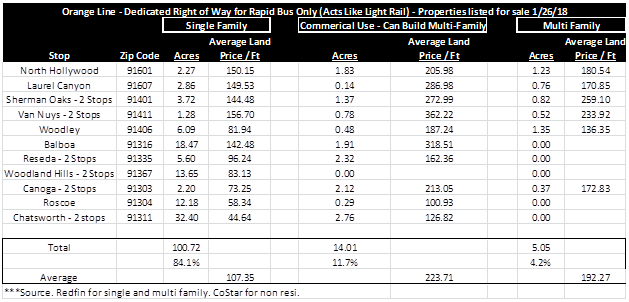
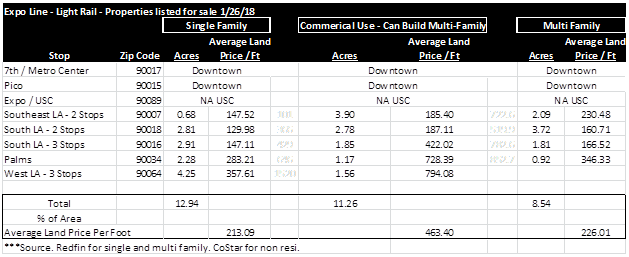
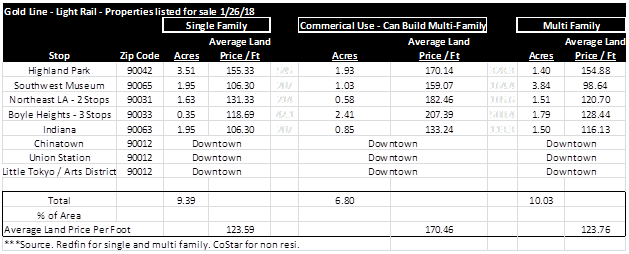

These tables show that the main reason for high housing costs in Los Angeles is that we have excluded two-thirds of the land near our rich transit from being redeveloped. We have treated single-family homeowners as an untouchable protected class. This has forced developers to chase a scarce supply of multifamily-zoned land, for which they must pay double the price per foot of what abundant single-family land costs. It should be no surprise that in 2017, the median price of single-family homes in Los Angeles County passed its all-time high from prior to the Great Recession.
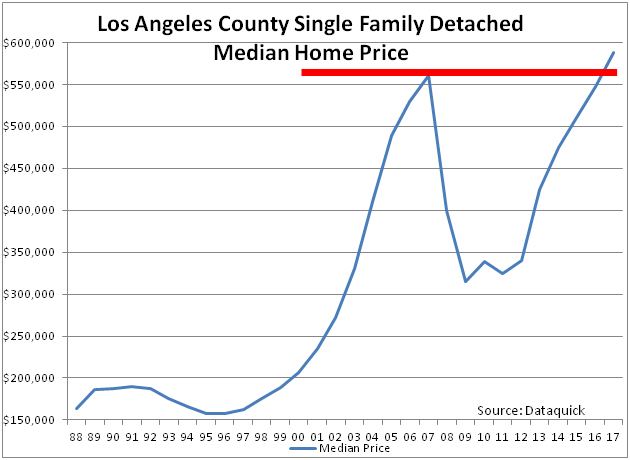
Historically, when housing prices have increased in Los Angeles County, so do the number of home sales. In previous cycles, peak closings reached over 100,000 per year in the county. This cycle is different: our closings today are only half of that of previous cycles. This is despite having a larger population than ever before, and the strongest housing market in history. We have created a historically unprecedented exclusionary environment where people are not moving from their homes at a normal rate.
This makes sense. Why should these homeowners move? They own a scarce asset in one of the greatest cities in the world that appreciates annually and is located next to new world-class transportation infrastructure.
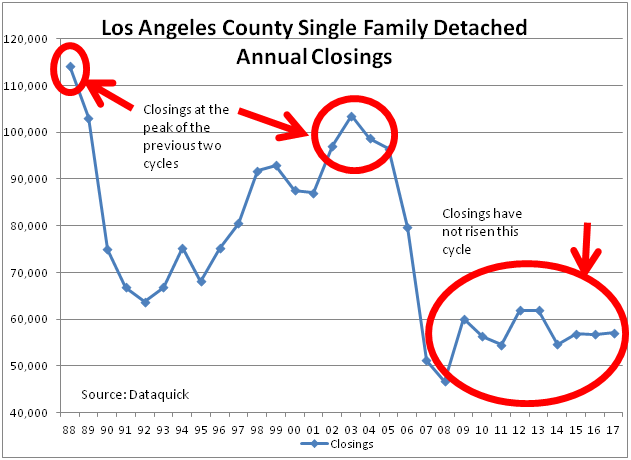
We have created a mess that is putting the future of the California dream in serious danger. California cannot continue to grow and remain the world’s fifth largest economy if we do not plan to adequately house our residents. Period. This is a problem for everyone, even the homeowners. Our state runs on tax revenues. The majority of tax revenue is not coming from property taxes fixed under Proposition 13.
Time is running out. Los Angeles is rapidly losing neighborhoods that remain affordable at today’s income levels. The nightmare scenario is zip code 90026 (Silver Lake / Echo Park). In 1997, Silver Lake was a centrally located, working-class neighborhood in Los Angeles. The median home price in 1997 per Data Quick was $139,500. During the past two decades, Silver Lake has stubbornly refused to add to their housing stock in any meaningful way, even as the neighborhood became popular for its central location. In December 2017, per Data Quick, the median sales price for a home in the 90026 zip code was $1,093,000. Let this serve as a real-life warning to the remaining affordable communities of Los Angeles. Add to your housing supply or you are next.
We need a great piece of legislation that addresses this economic injustice, and fortunately, we have one. In early January, State Senator Scott Wiener proposed Senate Bill 827 “SB 827”. The proposed legislation provides various levels of upzoning within a ½ mile radius of rich transit areas. If you want to read in detail how this is one of the most important economic, environmental, and social justice bills in California history you can do that here, here, here, here, here, here, here, here, and here. I want to describe how I as a builder would use this bill.

Right now in Los Angeles, developable land is so scarce that it is often priced above the residual land value that makes sense to develop housing. This $277/ft average reflects that. That is why in 2017, certificates of occupancy in the City of Los Angeles were down by over 20 percent from 2016. It is also why new multi-family building permits in 2017 were down by 1 percent from 2016. These are terrible statistics to have in a strong housing market with strong demand.
To develop housing, the price of land must come down. Although currently allowed, I don’t want to develop on the land that has multi-family units. Even though that land is priced lower, it would require evictions. Multifamily evictions in 2018 Los Angeles often turn lives upside down.
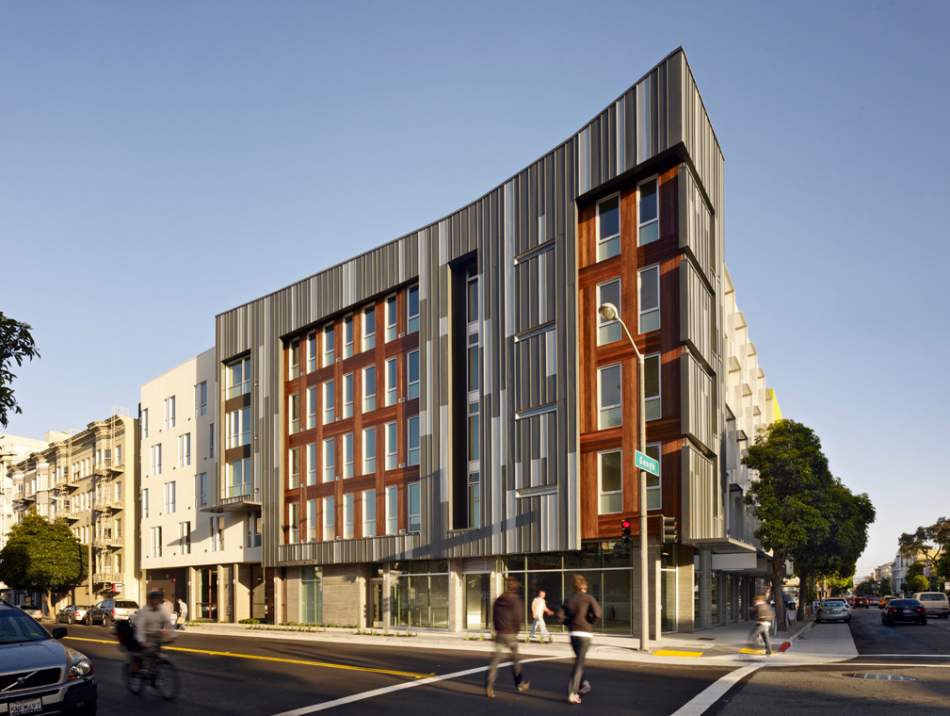
That leaves the single-family land that is abundant and reasonably priced. There is a common misconception that all single-family neighborhoods will transform into mid-rise buildings under SB 827 (such as the one seen here). This is completely untrue. First, as SB 827 is currently written this building would only be allowed on streets with sufficient width, Los Angeles City commercially zoned streets only. Second, this building is incredibly complicated and expensive to construct and develop. It would only appear on wide commercial boulevards in the state’s most expensive areas. This building is currently allowed on most of Los Angeles’s commercial boulevards. If it made financial sense to build this in working-class neighborhoods, developers would be doing it in bulk today. They are not.
These are four, attainably priced housing types that you can expect to see in transit-rich neighborhoods under SB 827.
Below is a 1,725 square foot detached condo in South Los Angeles. The home was built in 2013 and sold for $338,990.
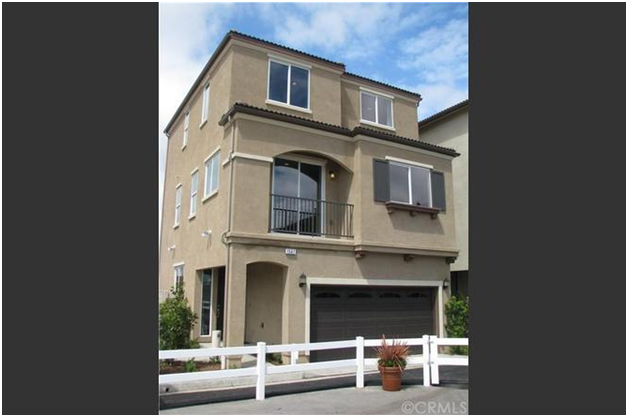
Here is a 3,200 ft duplex in South Los Angeles. The building was built in 2015 and sold for $569,000.
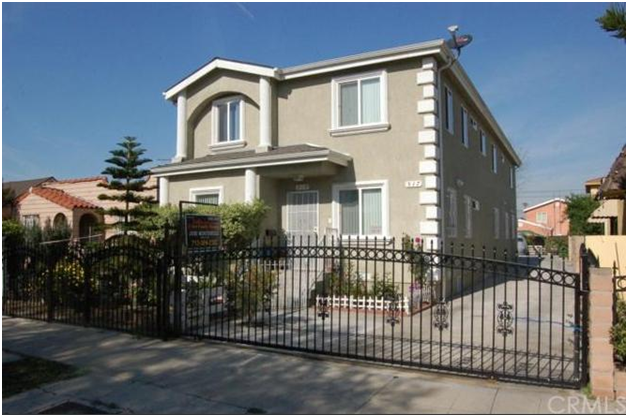
Below is a brand new fee simple townhome in the Sylmar neighborhood of Los Angeles ~1/4 from a rail stop. It is on the market for $497,900.
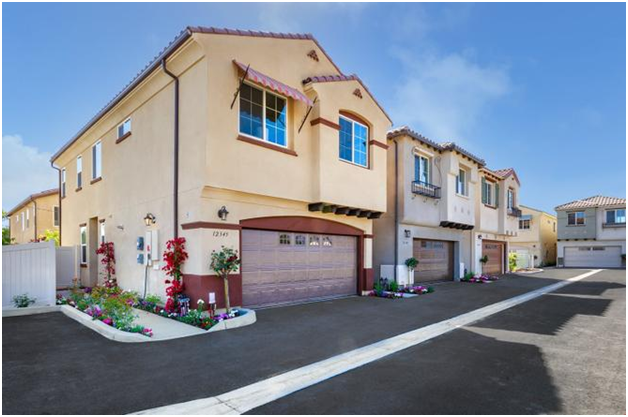
Finally, this is a 1,300 square foot fee simple townhome in Silver Lake (zip code) 90026. As I mentioned, the December 2017 median sales price for a home in the 90026 zip code was $1,093,000. This is priced at $774,000. A buyer will trade less land for a less expensive sales price. SB 827 will create this value proposition in transit-rich neighborhoods of all income levels all across the state.
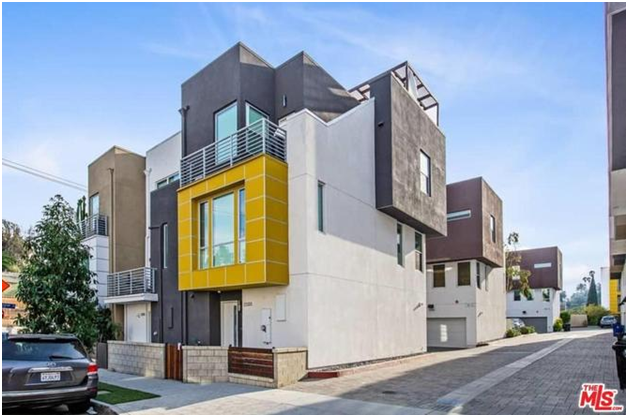
These four housing types will not destroy neighborhoods. Redevelopment is a process that occurs gradually over the course of many years.How gradually? I still count over 12,000 single family homes left in Los Angeles on lots zoned for multifamily use. Most of these homes have had that zoning in place for over 70 years.
I want to address some of the issues I have heard about the bill. There have been comments about demolitions and affordability requirements. Senator Weiner wrote that he plans to include anti-displacement provisions (like demolition controls and affordability requirements) in the bill, which I support.
Others have argued that the real problem is institutional companies that control many homes in working-class neighborhoods. Indeed, Blackstone has consolidated an industry that bought single-family foreclosed homes during the great recession, evicted the homeowners, and now rent back to these homeowners at rents higher than their previous mortgages. I hate this industry and believe that SB 827 will make it a thing of the past. This industry thrives on scarcity: they hate supply. In fact, nothing scares institutional investors more than supply. They even flaunt “low housing supply” as a “compelling industry fundamental” in the below investment package. Pass SB 827 to create the housing supply needed to get Blackstone to “divest their portfolio”.
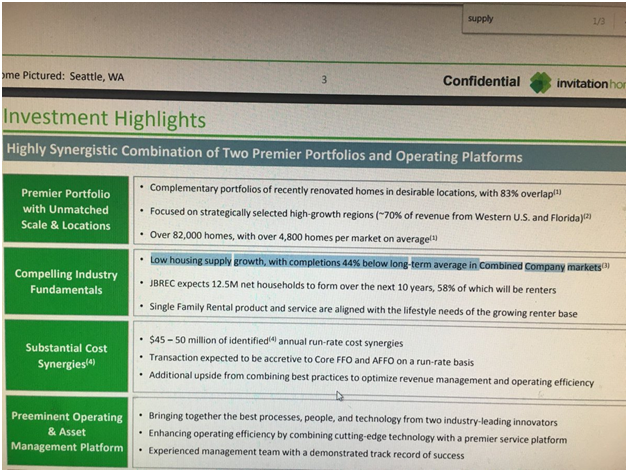
There have been comments about strengthening rent control protections. While this bill has nothing to do with that either way, I have expressed support for reform of the Costa Hawkins Act. The Costa-Hawkins Rental Housing Act is a state law that bans rent control on all single-family homes, all condos, and multi-family units built after 1995. Write a comprehensive reform of the bill that can get on the floor of the Legislature and I’ll support it. Great land use policies allow a California resident to graduate college, get a job, and if they desire, return to the neighborhood they grew up in and form a household. SB 827 keeps that possibility alive. Doing nothing makes that future scenario unlikely in many parts of the state.
There will inevitably be complaints about adding density to single-family neighborhoods. The bill only proposes adding density to neighborhoods within a ½ mile of rich transit. Over 95% of California land will be untouched. No one is being asked to move. The California dream includes providing adequate housing. The dream does not include providing single-family housing with single-family neighbors. Most major metropolitan areas around the globe have mixed density neighborhoods, especially by rich transit. It is time for California cities to get in line with other major cities and add the housing types I outlined. We can have a meaningful discussion on how these neighborhoods grow but not if they grow.
SB 827 has a challenging road ahead, but it must pass. Like all good legislation, it should go through regular order. Amendments should be considered from all 121 elected officials and all key interest groups in the state. The bill will change, and that is fine. The goal is to get to the finish line with legislation that tackles our current land use policies that promote economic inequality. This will be a difficult process, but it is worth it.
President Obama told David Letterman on his new Netflix show that nothing right in the world ever comes without at least some discomfort because "Somebody's benefiting from the status quo". Great legislation requires great leadership, often at risk to a political career. President Obama himself risked his own reelection pushing through the Affordable Care Act.
The Rumford Act was no different. After stalling out in the State Senate after leadership refused to call a vote, it took considerable arm-twisting from the governor and a pledge from then-Assembly Speaker Jesse Unruh to block all Senate bills from the Assembly Ways and Means Committee to force a vote. Its passage was costly. As Bill Boyarsky writes in this 1992 L.A. Times profile, "It was the beginning of the conservative tide that, two years later, elected Ronald Reagan governor and tossed Pat Brown out of office." Boyarsky continues, "What interested me about the way Brown handled this is how he willingly engaged in an act of political self-destruction for principle. He just knew that he wanted to leave for the next generation a California of economic opportunity and social justice."
Governor Jerry Brown proved last year that he is more than capable of getting tough votes through the current Legislature. As this video shows, he was willing to bang on tables, scream and point at legislators, and horse trade with Republicans to secure the 2/3rds votes needed to pass cap and trade and infrastructure bills.
But infrastructure and the cap and trade are not enough. To continue his father’s promise of the California dream we must address equitable and environmentally just zoning laws. Senate Bill 827 only needs a simple majority. In the last year of a political dynasty 59 years in the making, I hope the Brown family can give California this one last gift.\
@housingforla is a Los Angeles based residential developer. Follow him on Twitter @housingforla. For inquiries, email housingforla@gmail.com




